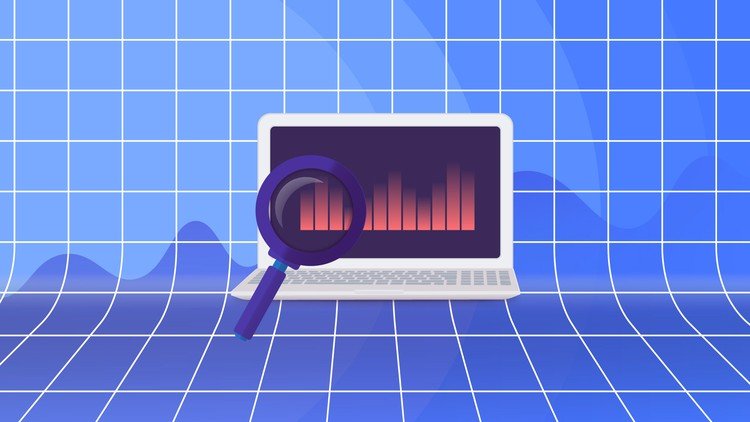Data Analysis with Pandas and Python
- Description
- Curriculum
- FAQ
- Reviews
Student Testimonials:
-
The instructor knows the material, and has detailed explanation on every topic he discusses. Has clarity too, and warns students of potential pitfalls. He has a very logical explanation, and it is easy to follow him. I highly recommend this class, and would look into taking a new class from him. – Diana
-
This is excellent, and I cannot complement the instructor enough. Extremely clear, relevant, and high quality – with helpful practical tips and advice. Would recommend this to anyone wanting to learn pandas. Lessons are well constructed. I’m actually surprised at how well done this is. I don’t give many 5 stars, but this has earned it so far. – Michael
-
This course is very thorough, clear, and well thought out. This is the best Udemy course I have taken thus far. (This is my third course.) The instruction is excellent! – James
Welcome to the most comprehensive Pandas course available on Udemy! An excellent choice for both beginners and experts looking to expand their knowledge on one of the most popular Python libraries in the world!
Data Analysis with Pandas and Python offers 19+ hours of in-depth video tutorials on the most powerful data analysis toolkit available today. Lessons include:
-
installing
-
sorting
-
filtering
-
grouping
-
aggregating
-
de-duplicating
-
pivoting
-
munging
-
deleting
-
merging
-
visualizing
and more!
Why learn pandas?
If you’ve spent time in a spreadsheet software like Microsoft Excel, Apple Numbers, or Google Sheets and are eager to take your data analysis skills to the next level, this course is for you!
Data Analysis with Pandas and Python introduces you to the popular Pandas library built on top of the Python programming language.
Pandas is a powerhouse tool that allows you to do anything and everything with colossal data sets — analyzing, organizing, sorting, filtering, pivoting, aggregating, munging, cleaning, calculating, and more!
I call it “Excel on steroids”!
Over the course of more than 19 hours, I’ll take you step-by-step through Pandas, from installation to visualization! We’ll cover hundreds of different methods, attributes, features, and functionalities packed away inside this awesome library. We’ll dive into tons of different datasets, short and long, broken and pristine, to demonstrate the incredible versatility and efficiency of this package.
Data Analysis with Pandas and Python is bundled with dozens of datasets for you to use. Dive right in and follow along with my lessons to see how easy it is to get started with pandas!
Whether you’re a new data analyst or have spent years (*cough* too long *cough*) in Excel, Data Analysis with pandas and Python offers you an incredible introduction to one of the most powerful data toolkits available today!
-
1Introduction to Data Analysis with Pandas and PythonVideo lesson
Welcome to Data Analysis with Pandas and Python. In this lesson, we
introduces the pandas library including its history and purpose
introduce Jupyter Notebook, the environment in which we'll be writing our code
explore sample Jupyter Notebooks to showcase some of the technology's features
The datasets for this course are available in a single pandas.zip file. Download and unpack the pandas.zip file in the directory of your choice.
-
2Completed Course FilesText lesson
This lesson includes the completed Jupyter Notebooks that were created during the recording of the course.
-
3About MeVideo lesson
Get to know a little about your instructor.
-
4macOS - Download the Anaconda Distribution, our Python development environmentVideo lesson
The next batch of lessons focuses on installing and configuring the Anaconda distribution on a MacOS machine. When downloading the distribution, choose the latest version of the language. It will have the greatest version number. In this lesson, we also discuss the differences between Python 2 and 3.
-
5macOS - Install Anaconda DistributionVideo lesson
In this lesson, we install the Anaconda distribution on a MacOS machine. The setup install Python and over 100 of the most popular libraries for data science in a central directory on your computer. We also explore the Anaconda Navigator program, a visual application for interacting with Anaconda.
-
6macOS - Access the Terminal ApplicationVideo lesson
The Terminal is an application for issuing text-based commands to your MacOS operating system. In this lesson, you'll learn two ways to access the Terminal. We also verify that Anaconda has been successfully installed and update the version of the conda environment manager.
-
7macOS - Create conda Environment and Install pandas and Jupyter NotebookVideo lesson
In this lesson, we use the Terminal to create a new Anaconda environment and install Pandas (and some other libraries) within it. We also learn how to activate and deactivate conda environments, and update packages.
-
8macOS - Unpack Course Materials + The Start and Shutdown ProcessVideo lesson
The course materials, a collection of datasets in .csv and .xlsx file formats, is available for download in a single zip file attached to this lesson. I strongly recommend following along with my tutorials by practicing the syntax on your end. In this lesson, we walk through the startup and shutdown process for a Jupyter Notebook session. We also execute our first line of Python code!
-
9Windows - Find Out if Your System is 32-bit or 64-bitText lesson
Discover if your Windows operating system is running a 32-bit version or a 64-bit version of the OS. You'll need to memorize this number for the next lesson.
-
10Windows - Download and Install the Anaconda DistributionVideo lesson
In this lesson, we'll download and install the Anaconda distribution for our Windows computers. Anaconda is a software bundle that includes Python and the conda environment manager.
-
11Windows - Create conda Environment and Install pandas and Jupyter NotebookVideo lesson
Access the Command Prompt on a Windows machine. The prompt (also known as the command line) is used to interact with the computer with text-based commands. We'll use it to download additional Python libraries for the course and update all installed Anaconda libraries.
-
12Windows - Unpack Course Materials + The Startdown and Shutdown ProcessVideo lesson
In this lesson, we extract our .csv and .xlsx datasets, which are available in a single .zip file attached to this lesson.. We also walk through the startup and shutdown process for a study session, which includes
activating the correct Anaconda environment
launching the Jupyter Notebooks application
opening and closing a Jupyter Notebook
shutting down the Jupyter server
-
13Troubleshooting Issues with Jupyter NotebookText lesson
This lecture walks you through fixing a possible issue with Autocomplete in Jupyter Notebook.
-
14Intro to the Jupyter Notebook InterfaceVideo lesson
In this lesson, we explore the Jupyter Notebook interface including the toolbars and menus. We also dive into the ways we can restart the Notebook in case of slowness or unresponsiveness.
-
15Cell Types and Cell Modes in Jupyter NotebookVideo lesson
In this lesson, we learn about the two different modes (Edit Mode and Command Mode) within a Jupyter Notebook. Edit Mode modifies the contents of a single cell while Command Mode enables keyboard shortcuts that work on the Notebook as a whole.
-
16Code Cell Execution in Jupyter NotebookVideo lesson
Learn the multiple keyboard shortcuts to execute code cells and Markdown cells. We'll also learn how Jupyter Notebook chooses what to output below a cell that has multiple commands.
-
17Popular Keyboard Shortcuts in Jupyter NotebookVideo lesson
In this lesson, we practice using keyboard shortcuts to add and delete cells from the Jupyter Notebook. We also see how to access a helpful cheatsheet of available commands.
-
18Import Libraries into Jupyter NotebookVideo lesson
In this lesson, we discuss how to use the import keyword to import libraries like panda and numpy into a Jupyter Notebook. We also talk about the as keyword to assign an alias to an import, as well as the popular community aliases for pandas and numpy.
-
19Setup & InstallationQuiz
Test your knowledge of the concepts introduced in this course section.
-
20Intro to the Python Crash CourseVideo lesson
In this lesson, we introduce the Python crash course, a quick bootcamp on the fundamentals on the Python programming language. This section is COMPLETELY OPTIONAL and is designed for students who have limited / no experience in coding.
-
21CommentsVideo lesson
A comment is a line of code that is ignored by the Python interpreter. You can use it to disable code, to leave documentation, or to write explanations.
-
22Basic Data TypesVideo lesson
This lesson introduces Python's basic data types including integers, floats, strings, Booleans, and the None object. All of these data structures are objects. An object is just a digital container for data.
-
23OperatorsVideo lesson
In this lesson, we go back to grade school and practice using common mathematical operators for addition, subtraction, division, and multiplication. We also explore some special operators like modulo that you may not have used before.
-
24VariablesVideo lesson
A variable is a name assigned to an object in the program. It is subject to change; a variable can be reassigned to a different value throughout a program's execution.
-
25Declare VariablesQuiz
-
26Coding Exercise Solution: Declare VariablesText lesson
See the solutions to the coding exercise in the previous lesson.
-
27Built-in FunctionsVideo lesson
A function is a recipe, a set of repeatable instructions for achieving some outcome. Functions accept inputs called arguments and produce an output called a return value. In this lesson, we practice invoking Python's built-in functions including len, str, float, int, and more.
-
28Built-in FunctionsQuiz
-
29Coding Exercise Solution: Built-in FunctionsText lesson
See the solutions to the coding exercise in the previous lesson.
-
30Custom FunctionsVideo lesson
In this lesson, we define our own custom function to convert a temperature from Celsius to Fahrenheit. A custom function allows us to encapsulate a piece of repeatable business logic.
-
31Custom FunctionsQuiz
-
32Coding Exercise Solution: Custom FunctionsText lesson
See the solutions to the coding exercise in the previous lesson.
-
33String MethodsVideo lesson
In this lesson, we introduce string methods like upper, lower, title, replace, and more. A string is an immutable object so it is incapable of change. These methods return new string objects.
-
34String MethodsQuiz
-
35Coding Exercise Solution: String MethodsText lesson
See the solutions to the coding exercise in the previous lesson.
-
36ListsVideo lesson
A list is a mutable data structure for storing elements in order. In this lesson, we declare some sample lists of various data types and explore some common methods for list manipulation.
-
37Creating ListsQuiz
-
38Coding Exercise Solution: Creating ListsText lesson
See the solutions to the coding exercise in the previous lesson.
-
39Index Positions and SlicingVideo lesson
Indexing or slicing refers to extracting one or more elements from a data structure like a string or a list. In this lesson, we introduce the square bracket syntax for indexing.
-
40Index Positions and SlicingQuiz
-
41Coding Exercise Solution: Index Positions and SlicingText lesson
See the solutions to the coding exercise in the previous lesson.
-
42DictionariesVideo lesson
A dictionary is a mutable, unordered collection of key-value pairs. Dictionaries are ideal for creating associations or relationships between objects. In this lesson, we build up a dictionary representing a restaurant menu, then demonstrate how to add, remove, and modify key-value pairs within it.
-
43Creating DictionariesQuiz
-
44Coding Exercise Solution: Creating DictionariesText lesson
See the solutions to the coding exercise in the previous lesson.
-
45Completed Jupyter Notebook for this SectionText lesson
Downloaded the completed Jupyter Notebook for the course section.
-
46Python Crash CourseQuiz
Test your knowledge of the concepts introduced in this course section.
-
47Create Jupyter Notebook for the Series ModuleVideo lesson
In this lesson, we create a new Jupyter Notebook for the Series section of the course. The pandas Series object is a one-dimensional labelled array that combines the best features of a Python list and a Python dictionary.
-
48Create A Series Object from a Python ListVideo lesson
A pandas Series can be created with the pd.Series() constructor method. In this lesson, we'll practice creating a few sample Series by feeding in Python lists as inputs to the constructor method.
-
49Create A Series Object from a Python DictionaryVideo lesson
The pd.Series constructor method accepts a variety of inputs, including native Python object. In this lesson, we'll create a Series from a Python dictionary. We'll also explore the differences between the Series and Python's built-in objects, and understand how the index operates in a Series.
-
50Create a Series Object v2Quiz
-
51Coding Exercise Solution: Create a Series ObjectText lesson
See the solutions to the coding exercise in the previous lesson.
-
52Intro to MethodsVideo lesson
In this lesson, we continue our exploration of methods on the Series object. We practice with the sum, mean, and product methods.
-
53Intro to AttributesVideo lesson
Objects in pandas have attributes and methods. Methods actively interact with and modify the object while attributes return information about the object's state. In this lesson, we'll use the values, index, and dtype attributes on a Series object.
-
54Attributes and Methods on a SeriesQuiz
-
55Coding Exercise Solution: Attributes and Methods on a SeriesText lesson
Explore the solution for the previous coding challenge.
-
56Parameters and ArgumentsVideo lesson
Parameters are names for the inputs that a function/method will receive when invoked. Arguments are the values we provide for those parameters when the function/method is invoked. In this lesson, we'll learn the syntax of supplying arguments to parameters on pandas methods.
-
57Parameters and ArgumentsQuiz
-
58Coding Exercise Solution: Parameters and ArgumentsText lesson
See the solution to the coding exercise in the previous lesson.
-
59Import Series with the pd.read_csv FunctionVideo lesson
The time has come to import our first datasets into our Jupyter Notebook ! In this lesson, we use the pd.read_csv method to import a dataset of Pokemon and Google stock prices. We also explore the squeeze method, which coerces an imported one-column DataFrame into a Series object.
-
60Import Series with the read_csv FunctionQuiz
-
61Coding Exercise Solution: Import Series with the read_csv FunctionText lesson
See the solutions to the coding exercise in the previous lesson.
-
62Use the head and tail Methods to Return Rows from Beginning and End of DatasetVideo lesson
In this lesson, we learn the head and tail methods for returning a specified number of rows from the beginning and end of a Series.
-
63The head and tail MethodsQuiz
-
64Coding Exercise Solution: The head and tail MethodsText lesson
See the solutions to the coding exercise in the previous lesson.
-
65Passing Series to Python Built-In FunctionsVideo lesson
See how the Series interacts with Python's built-in functions including len, type, sorted, list, dict, max, and min. pandas works seamlessly with all of them.
-
66The sort_values MethodVideo lesson
In this lesson, we invoke the sort_values method to sort a Series in ascending or descending order.
-
67The sort_values MethodQuiz
-
68Coding Exercise Solution: The sort_values MethodText lesson
See the solutions to the coding exercise in the previous lesson.
-
69The sort_index MethodVideo lesson
Call the .sort_index() method on a pandas Series to sort it by the index instead of its values.
-
70The sort_index MethodQuiz
-
71Coding Exercise Solution: The sort_index MethodText lesson
See the solution to the coding challenge in the previous lesson.
-
72Check for Inclusion with Python's in KeywordVideo lesson
We can use Python's in keyword to check if a value exists in either the values or index of a Series. By default, pandas will search for the value in the Series index.
-
73Check for Inclusion with Python's in KeywordQuiz
-
74Coding Exercise Solution: Check for Inclusion with Python's in KeywordText lesson
See the answers to the coding challenge in the previous lesson.
-
75Extract Series Values by Index PositionVideo lesson
In this lesson, we walk through how to use square bracket notation to extract one or more Series values by their index position. The index position represents the order of the row within the Series.
-
76Extract Series Values by Index LabelVideo lesson
In this lesson, we explore how to use use bracket notation to extract one or more values from a Series by their index labels.
-
77Extract Series Values by Index Position or Index LabelQuiz
-
78Coding Exercise Solution: Extract Series Values by Index Position or Index LabelText lesson
See the solutions to the coding exercise in the previous lesson.
-
79The get MethodVideo lesson
In this lesson, we explore an alternative approach to extracting one or more values from a Series by index position or index label. The get method accepts the key to search for in the index as well as a fallback to value in return if the key is not found.
-
80Overwrite a Series ValueVideo lesson
In this lesson, we use square bracket syntax to overwrite a Series value at a given index position/index label.
-
81The copy MethodVideo lesson
In this lesson, we discuss the differences between copies and views. We also learn how to use the copy method to create a distinct, independent clone of an existing pandas object.
-
82The inplace ParameterVideo lesson
In this lesson, we learn about the inplace parameter, which "modifies" an object inplace. As we find out, this is a bit of an illusion as pandas still creates a copy of the original object behind the scenes.
-
83Math Methods on Series ObjectsVideo lesson
In this lesson, we practice invoking common mathematical methods including count, sum, mean, and std on Series objects.
-
84BroadcastingVideo lesson
In this lesson, we introduce the syntax for broadcasting, which allows us to apply the same mathematical operation to each Series value.
-
85Use the value_counts Method to See Counts of Unique Values within a SeriesVideo lesson
In this lesson, we learn the value_counts method. It returns a Series that counts the number of the times each unique value occurs in a Series.
-
86The value_counts MethodQuiz
-
87Coding Exercise Solution: The value_counts MethodText lesson
See the solutions to the coding exercise in the previous lesson.
-
88Use the apply Method to Invoke a Function on Every Series ValuesVideo lesson
In this lesson, we use the apply method to invoke a function on every Series value. The method returns a new Series with the resulting calculations (i.e. return values).
-
89The map MethodVideo lesson
In this lesson, we use the map method to associate Series values to other values based on mapping object. We practice with a Python dictionary and another Series object.
-
90Completed Jupyter Notebook for this SectionText lesson
Downloaded the completed Jupyter Notebook for the course section.
-
91A Review of the Series ModuleQuiz
Review the pandas Series concepts you explored in this module with this action-packed quiz!






